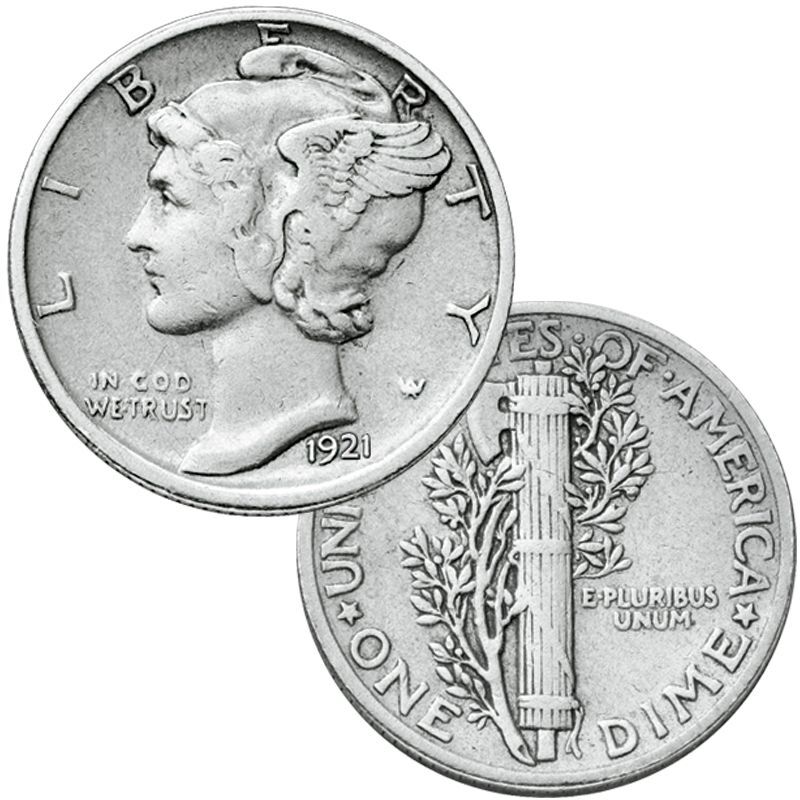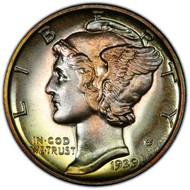Why Mercury Dimes Need To Be In Your Collection: Design, Values and Key Dates
Posted by Bullion Shark on Oct 27th 2021
Why Mercury Dimes Need To Be In Your Collection
The silver dimes, quarters and half dollars introduced in 1892 each featured the same design by Charles Barber of a Liberty that looked Roman in appearance and reflected the conservative, Victorian artistic style of the time. But as the American nation evolved over the 25 years those coins were issued, so did artistic sensibilities.

The 1910s in particular were a period of reform in our government and economy known as the Progressive Age. By this time there were growing calls for new coinage to replace the staid Barber coins. In 1914, coin dealer Thomas Elder of the New York Numismatic Club petitioned the U.S. Treasury department for “more artistic designs,” adding that the depiction of Liberty on those coins was “an insult both to the Goddess of Liberty and to the beauty of American womanhood.”
That petition combined with the 19th century law that allowed the Treasury to change designs once they had been used for 25 years, which would be in 1916 in this case, set in motion the development of new designs for each of those three silver coins for the first time in our history.
Rather than holding an open design competition, the Mint instead sent invitations to a number of prominent American sculptors to prepare designs, including Adolph Weinman, Hermon H. McNeil and others. They also asked Chief Engraver Barber to prepare design models, but that was a mere formality, and the ones he prepared were rejected.
Mercury Dime
The design by Weinman selected for the dime, which numismatists refer to as the Winged Liberty Head or Winged Liberty dime, featured an obverse with a left-facing side profile or bust of a female figure representing Liberty who sports a cap with wings that the designer intended to symbolize liberty of thought.
But because it bore some resemblance to the Roman male god Mercury who had wings attached to his head, it soon was misattributed in the popular press as the Mercury dime.
The reverse featured a bundle of rods with a battle ax known as fasces, which were used by guards during Roman times, which was intended to represent preparedness to defend the union, surrounded by a branch of olive that symbolized peace.
Keep in mind the coin was issued at a time of growing calls for the U.S. to enter World War I, which explains the particular symbolism of the reverse design. The design was immediately popular with most members of the public and coin collectors, especially from the 1930s on once coin albums became widely available.
The bust on the obverse was based on a combination of a bust the artist had prepared in 1912-13 of Elsie Stevens, wife of lawyer Wallace Stevens. The Stevens’ rent an apartment from Weinman at the time as well as Weinman’s Union Soldiers and Sailors Memorial in Baltimore from 1909. The statue of victory in that memorial also wears a cap.
Release of the Mercury dime was delayed until October 1916 despite the urgent need for new silver coinage at the time due to some problems executing the design into coins that concerned the inscriptions, relief and other issues, and which still had to be modified later.
Silver Dime Value
Silver dimes made of 90% silver contain 0.0723 ounces of silver, giving them a current melt value of about $1.80.
In low circulated grades common-date Mercury dimes are worth about $4-5, while an MS60 runs $10, an MS65 $30, and the top grade of MS68 is about $350. But with Full Bands the MS68 coins jump to at least $1,000 and as much as almost $6,000 for MS68+.
Common dates are readily available by the roll.
Mercury Dime Key Dates
The main key dates for this series are 1916-D, 1921 and 1921-D.
1916-D
In 1916 production of dimes was halted after only 264,000 were made because of the sudden and urgent need for quarters to be made there, which is why this coin has emerged as the low-mintage key date of the Mercury dime series. The demand for dimes that year was mostly filled by the 1916-S coins.
Be ware of fake examples of this date because of its high value in all grades, and it is highly advisable to buy examples graded by PCGS or NGC.
Even in low circulated grades, this issue is worth $1250 in Good all the way to $200,000 in MS67 with Full Bands.
In XF40 it is $6,000, MS60 runs $12,500 and mint state coins of higher grades just get more and more expensive up the grade ladder.
As for 1921, it is $60 in Good, $500 in XF, $1650 in MS60 and $35,000 in MS67 with Full Bands. Only 1.2 million were made because of the reduced need for coinage during the economic recession of that period, and in 1922 no dimes were produced at all. This is the same reason why only 1,080,000 of the 19210D dime were made.
The 1921-D is rarer than 1921 in circulated grades that is the best many collectors can afford and starts at $100, runs $750 in XF, $1650 in MS60 and reaches $45,000 in MS67 with Full Bands.
1941
1941 is one of the most common dates for the Mercury dime series except for the famous 1942/41 and 1942/41-D overdate coins made by taking a 1941 working die and overpunching it with a 1942 die.
Both of those are worth from about $400 in good to $3,000 in MS60 and as much as $85,000 for MS66 Full Bands for 1942/41 and $125,000 for MS67 FB for the 1942/41-D.
Mercury dimes, which were issued through 1945, and short sets of the coins from 1941-1945 are very popular. They will undoubtedly remain a staple for collectors of 20 th century U.S. coins for the indefinite future. It was also reissued in gold in 2016 to mark the centennial since the Mercury dime debuted.


